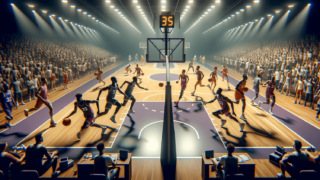
Five-Second Inbound Rule in Basketball
Written by: Basketball Universe
Last updated:

Welcome to the world of basketball, where every second counts, and even a minor rule could make a huge difference in the outcome of the game! In this action-packed blog post, we’re going to dive into the fascinating world of the Five-Second Inbound Rule – a lesser-known, yet crucial aspect of the game that has left many players and spectators scratching their heads. If you’re eager to up your basketball IQ and impress your friends with your in-depth knowledge, you’ve come to the right place. So, fasten your high-tops and prepare to unravel the mysteries of this intriguing rule. Let the fun begin!
Five-Second Inbound Rule in Basketball
The Five-Second Inbound Rule in basketball refers to the regulation that a player has a maximum of five seconds to throw the ball inbounds after a stoppage in play. During this time, the player must release the ball to a teammate on the court. If the player fails to do so within the five-second window, a turnover occurs, and possession is awarded to the opposing team. This rule encourages quick decision-making and maintains the fast pace of the game.
A Deep Dive into the Five-Second Inbound Rule
Now that we’ve briefly touched on the essence of the Five-Second Inbound Rule in basketball, it’s time to delve deeper and truly understand how this rule functions and why it’s so important in the sport. You’ll soon find that, like many other basketball rules, the Five-Second Inbound Rule has its intricacies and variations. So, let’s start our journey by looking at the foundation of this regulation.
Inbounding the Basketball: A Quick Recap
Inbounding the basketball is an essential part of the game that takes place after a stoppage in play. When the game is paused due to various reasons – such as the ball going out of bounds, a foul being called, or a timeout – inbounding helps restart the action. The purpose of the Five-Second Inbound Rule is to keep the game moving at a fast pace and avoid any unnecessary delays or stalling tactics. The rule applies to all levels of basketball, from youth leagues to the professional stage.
The History of the Five-Second Inbound Rule
The Five-Second Inbound Rule was first introduced in college basketball during the early 20th century. It was initially implemented to prevent players from deliberately wasting time to secure a lead, which didn’t align with the dynamic and fast-paced spirit of the game. Since then, the rule has undergone several revisions and alterations, some of which are specific to different leagues and levels of play. Despite these tweaks, the rule’s primary goal remains the same – to maintain a swift and exciting basketball experience.
Unraveling the Five-Second Variations
While the basic principle of the Five-Second Rule is straightforward, the specific application of the rule can vary across different competitions and leagues. Let’s look at a few notable examples that showcase this diversity.
National Basketball Association (NBA) Rules
In the NBA, the Five-Second Inbound Rule has two separate components: the five-second throw-in countdown and the closely guarded rule. The throw-in countdown is standard and applies as we have previously described. On the other hand, the closely guarded rule states that after successfully inbounding the ball, a player being closely guarded by a defender cannot hold the ball for more than five seconds without dribbling, passing, or attempting a shot.
National Collegiate Athletic Association (NCAA) Rules
As for the NCAA, the men’s and women’s basketball rules also feature the five-second throw-in countdown, the closely guarded rule, and an additional regulation known as the five-second back-to-the-basket rule. This rule states that a player who is in their frontcourt (the half of the court where their basket is located) and dribbling with their back to the basket cannot hold the ball for more than five seconds once they fall below the extended free throw line.
Federation Internationale de Basketball (FIBA) Rules
Under FIBA rules, the five-second throw-in rule is the only instance where a violation could occur. The closely guarded rule and the back-to-the-basket rule are not enforced in international competitions.
Executing a Perfect Inbound Pass: Tips and Tricks
Now that we’ve covered the nitty-gritty of the Five-Second Inbound Rule, it’s time to understand how players can master the art of inbounding within the allowed time frame. In a sport where each possession can be crucial to the outcome, a well-executed inbound pass is critical to success.
The Art of Deception
A little deception can go a long way when taking an inbound pass. A wise inbounder can make use of fake passes, maintain eye contact with their teammates, and keep their back to the defense. This way, they can make it more difficult for defenders to predict and intercept their next move.
Create Space with Screens and Set Plays
Another key aspect of executing a successful inbound pass is engaging in clever off-the-ball movement. Teams must use screens and well-rehearsed set plays to create enough space for the intended recipient to catch the ball without interference. This strategy enables the inbounder to have a clear target, making it easier for them to complete the task before the five-second countdown expires.
Stay Calm and Composed
No matter the level of play, remaining composed under pressure is essential for success in basketball. Inbounding the ball within five seconds might seem like a trivial task, but doing so while being closely guarded by aggressive defenders can be quite challenging. It’s critical for the player inbounding the ball to remain calm, focus on their mental preparation, and avoid panicking, even when the clock is ticking down.
The Impact of the Five-Second Inbound Rule on the Game
At first glance, the Five-Second Inbound Rule might appear to be a minor regulation in the world of basketball rules. However, its impact on the game cannot be underestimated. This seemingly simple rule plays an important role in shaping the sport to be the thrilling and dynamic spectacle we’ve come to love.
The Speed Factor
Promoting an up-tempo, fast-paced game has always been a priority for basketball organizations. The Five-Second Inbound Rule is crucial in keeping the speed of the game in check. A game without time restrictions on inbounding might result in unnecessary delays and stalling, a far cry from the exhilarating experience basketball enthusiasts have come to expect.
The Tactic Element
The Five-Second Rule’s time constraint adds another layer of strategic thinking to basketball, as coaches must design plays and schemes that allow inbounders to find an open teammate quickly. Additionally, defenders must apply pressure and force the inbounder to make a mistake or commit a turnover. These aspects significantly contribute to the tactical dimension of basketball, making the sport more enthralling and engaging.
Clutch Moments and Time Management
When the game is down to the wire, time management becomes crucial. In these high-pressure situations, smart inbound plays and quick thinking can be the deciding factor between victory and defeat. The Five-Second Inbound Rule enforces urgency and rewards teams that can manage the pressure and execute flawlessly under tight time constraints.
In Conclusion: The Importance of the Five-Second Inbound Rule in Basketball
Throughout this in-depth exploration of the Five-Second Inbound Rule, we’ve seen that this regulation, though seemingly minor, plays a pivotal role in shaping the sport of basketball. By enforcing quick thinking, tactical play, and effective time management, the rule helps ensure a fast-paced and engaging game. The next time you’re watching or playing basketball, take a moment to appreciate the finesse and skill involved in mastering the Five-Second Inbound Rule – a rule that truly makes all the difference.
Mastering the Five-Second Inbound Rule: Drills and Exercises
Given the importance of the Five-Second Inbound Rule in basketball, it’s crucial for players to practice executing successful inbound passes. Incorporating drills and exercises focused on this aspect of the game can make a significant difference in their performance. Let’s explore some valuable drills that can improve a team’s inbounding skills and minimize the risk of violations.
Baseline Inbound Drills
Baseline inbounding is among the most challenging types of inbound passes due to the limited space and proximity to the defending team’s basket. The following drills can help players get more comfortable with this high-pressure situation:
- Box Drill: Four offensive players stand at the corners of the key (also called the paint), while the defensive players mark them closely. The inbounder must make quick decisions, faking and passing the ball to a teammate. The offense practices creating space using screens and cuts, while the defense works on denying the inbound pass.
- Three-on-Three Half-Court Inbound: In this drill, teams alternate between offense and defense after a successful inbound pass. Coaches can focus on specific sideline or baseline inbound plays, encouraging players to execute under pressure while maintaining composure.
Sideline Inbound Drills
Successful sideline inbounding relies on effective off-the-ball movement, utilizing screens to create open passing lanes. These drills can enhance players’ ability to inbound under sideline conditions:
- Fives Drill: An inbounder and four teammates position themselves in a diamond or square formation. Each player must create space using a series of screens and cuts. The inbounder passes to the open player, who then becomes the next inbounder. All players rotate through inbounder and receiver roles, simulating a fast-paced game scenario.
- Two-on-Two Sideline Inbound: A simple yet effective drill that involves two offensive players executing a set inbound play against two defenders. The offensive players practice creating space and communicating to ensure a clean pass, while the defense practices denying and intercepting the inbound pass.
Miscellaneous Five-Second Situations in Basketball
In addition to the Five-Second Inbound Rule, basketball has a few other instances where a five-second count is used. Understanding how these situations contribute to the game’s pace and strategy can be beneficial to both players and fans alike.
Five-Second Lane Violation
A player who receives the ball in the key area is allowed only five seconds to shoot, pass, or dribble out of the key. This regulation, known as the five-second lane violation, is essential in preventing players from stalling the game and monopolizing possession. Notably, this rule applies in NBA, NCAA, and FIBA play.
Five-Second Backcourt Violation
In the NCAA, a specific variation of the backcourt violation rule exists. When a player is being closely guarded in their backcourt, they have five seconds to advance the ball past half-court. Failure to do so results in a turnover. This rule is similar to the ten-second backcourt violation in the NBA and FIBA; however, it raises the pressure on the ball handler and encourages a faster-paced game.
Famous Five-Second Inbound Rule Moments
There are moments in basketball history where the Five-Second Inbound Rule came into the spotlight, showcasing how crucial this seemingly minor rule can be in determining a game’s outcome. Let’s relive some of these memorable moments:
- 2011 NBA Eastern Conference Finals, Game 5: In a critical matchup between the Chicago Bulls and the Miami Heat, the Bulls failed to inbound the ball in the final seconds, leading to a turnover and subsequently losing the game. The Heat capitalized on their advantage, went on to win the series, and ultimately captured the NBA championship.
- 2014 NCAA Men’s Championship: In the final seconds of a heated contest between the Kentucky Wildcats and the Connecticut Huskies, Kentucky’s inability to inbound the ball within the allotted time led to a turnover. The Huskies secured the win and took home the national title.
These instances highlight the importance of mastering the Five-Second Inbound Rule and how it can impact the outcome of high-stakes games. Players and coaches should dedicate time and practice to this aspect of the game to avoid costly mistakes that could
FAQ: Five-Second Inbound Rule in Basketball
We understand that some questions might still linger in your mind after diving into the world of the Five-Second Inbound Rule. To address your queries, we have compiled a list of frequently asked questions with concise and informative answers. Let’s explore these common questions and develop a clearer understanding of this intriguing rule.
1. What is the purpose of the Five-Second Inbound Rule?
The primary purpose of the Five-Second Inbound Rule is to maintain the fast pace and dynamic nature of basketball by ensuring that players restart the game quickly after a stoppage in play. It prevents players from stalling or wasting time and encourages quick decision-making.
2. Does the Five-Second Inbound Rule apply in all leagues and competitions?
Yes, the Five-Second Inbound Rule is implemented across all levels and leagues of basketball, including the NBA, NCAA, and FIBA. However, there may be slight variations regarding the enforcement of the rule in different leagues.
3. Are throw-in violations called frequently during a game?
While Five-Second Inbound Rule violations are not among the most common infractions in basketball, they do occur occasionally, especially in high-pressure situations. It’s important for players to be aware of the rule and practice effective inbounding techniques to avoid turnovers.
4. How is the five-second count officiated?
The five-second count is officiated by an on-court referee, who initiates the countdown once the inbounder possesses the ball and is ready to make a throw. The referee uses a visible arm gesture to signal each count, making it easier for both the inbounder and spectators to track the time elapsed.
5. Can the inbounder dribble the ball before passing it?
No, the inbounder is not allowed to dribble the ball before passing it to a teammate. If the inbounder dribbles the ball before releasing it, a turnover occurs, and possession is awarded to the opposing team.
6. What happens if the inbounder steps over the boundary line while attempting to pass?
If the inbounder steps over the boundary line while attempting an inbound pass, a violation occurs, and the opposing team gains possession of the ball. It’s important for the player to maintain proper foot positioning to avoid such mistakes.
7. How can a player become a better inbound passer?
To improve as an inbound passer, players should practice deception (for instance, by utilizing fake passes and eye contact), engage in off-the-ball movement by setting screens and learning set plays, and stay calm and composed under pressure. Additionally, participating in drills tailored to inbounding can significantly enhance their skills.
8. What are some other five-second rules in basketball?
Besides the Five-Second Inbound Rule, other five-second rules in basketball include the five-second lane violation, where a player in the key must shoot, pass, or dribble out of the key within five seconds, and specific backcourt violation rules in NCAA play.
9. Can a player call a timeout during the five-second inbound countdown?
Yes, a player can call a timeout during the five-second inbound countdown to avoid a violation, provided that their team has remaining timeouts. However, it’s essential for players to communicate and use timeouts wisely as they can be valuable during clutch situations.
10. Are there instances where the Five-Second Inbound Rule has influenced the outcome of a game?
Yes, there have been moments in professional and collegiate basketball where a team’s inability to inbound the ball within five seconds led to critical turnovers and subsequently influenced the outcome of the game. Players and coaches must recognize the importance of mastering the rule to avoid such costly mistakes.
Featured Posts
- No pillar pages found.





